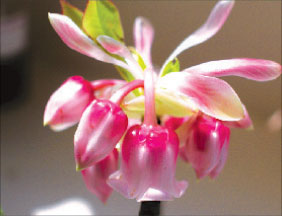The
Lunar New Year begins with brighter hopes than ever, when sparrows fly swiftly and lively above us in the Hong Kong countryside. Babbling streams sing the songs of spring.
New Year plants are not only for decoration or as lucky charms, they illustrate the hope of a better environment.
A hike during this time helps us work off all that greasy food, and gives us a good chance to appreciate the Chinese New Year flowers called Tiu Chong in full blossom in the wilderness of the New Territories' Wong Lung Heng on Lantau Island, throughout Sai Wan in Sai Kung. I have been going into the hills for this special species every year.
Its clusters of flowers are like a looming crown with more than five small hanging bells. When they sway in the wind, I feel as if I can even hear their ringing somewhere in my dream, as sweet as silver tinkle-bells.
If you spot someone picking this flower, feel free to warn them that it's a rare species that's disappearing from the region. The Hong Kong government has listed this flower as an endangered species due to rampant chopping and collecting.
Other famous New Year flowers include mahogany, narcissus, gladiolus and chrysanthemum, and recently, orchid has also become popular. People in Hong Kong get themselves ready for Chinese New Year by visiting flower markets in most Hong Kong districts. It is quite a scene for tourists. You will be amazed by citizens from all walks of life holding these flowers with hopes. Another special flower is the "nipple fruit"; it belongs to the family solanaceae, same as the tomato, which we can tell by the flower's characteristic purplish flower. In Chinese literature, the blessing of this flower is "five generations in one household".
I still remember that when my mother was still alive, she used take a hot bath infused with Pomelo leaves on the eve of Chinese New Year.
My hakka friend, however, opts to use Camphor leaves instead. Both leaves contain a fragrant oil that releases a refreshing aroma when heated. People believe that this special aroma helps get rid of bad luck in the coming year. Also, the pronunciation of Pomelo in Chinese is very similar to that of "blessing".
The tangerine, which is also a Chinese New Year favorite, belongs to the same family of Pomelo. The tangerine represents "gold" and "good luck"; people love its golden fruit, as well as its unifoliate compound leaf, which is a tiny, elongated leaflet in between the leaf and stalk. There is also the custom of putting a willow branch at the front door to ward off bad luck.
New Year foods and snacks are selected also for their meaning and wishful blessing to friends and relatives. Sweet coconut strips symbolize a happy family gathering. The seeds of the Hindu Lotus relate to having multiple sons - a wish not quite fashionable nowadays in Hong Kong. Sweetened lotus root symbolizes a strong bond between lovers, as the connective tissues are so numerous. In our culture, poets use lotus to represent purity and respect.
The Blood-flower is another festival plant adored by local people. Its outstanding flower structure is like the moon on a lotus. This plant is usually cultivated at the boundary of villages such as Pui O and the butterfly garden at Fung Yuen in Tai Po. Though it looks very attractive, it belongs to the poisonous family Asclepiadaceous. This plant is not edible for people, but it's delicious and nutritious for butterflies.
Starting this month, you will find various kinds of wild azaleas blooming around Ma On Shan. White Hawthorns can also be seen over almost any vista of the hillsides. These are the signs of spring in Hong Kong.
The author is the marketing development director of HK Discovery.
(China Daily HK Edition February 1, 2008)






